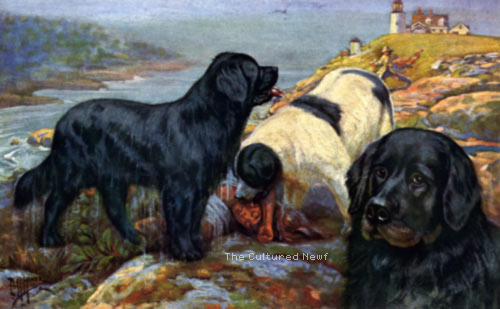[ Lloyd / "Working Dogs of the World"]
This article, by Freeman Lloyd, was one of a series of articles on "Dogs of the World" which appeared in National Geographic starting in 1936. "Working Dogs" of the title does not mean the same as the AKC group of "Working Dogs"; Lloyd's article includes sections on herding breeds as well as on breeds in today's "Working" group. This article appeared in National Geographic 41 (Dec. 1941): 769 - 806, and was accompanied by paintings by Edward Herbert Miner.
The section on Newfoundlands begins on p. 789:
The Newfoundland Dog, whose nobility of character, imposing presence, and general good temperament have endeared him to millions, takes his name from the oldest of the English colonies, where his ancestors were brought by sailors and the earliest of settlers from Europe.
A ship's dog was taught to leap overboard and swim for shore, bearing in his mouth the end of a small, light rope. To this a heavier rope could be made fast and used as a safe means for human beings to reach land.
Thus the ship's dog became its lifesaving apparatus. With his four legs he could swim where men might founder; his grip on the rocks would be easier and firmer than that of a man. Ships' dogs were, and still are, taught also to rescue a "man overboard."
Apparently the explorers' and codfishermen's retriever dogs which were left with the settlers in Newfoundland produced bigger and bigger offspring in their new homes. When these larger dogs were taken to Europe, they were given the name they now bear.
It is recorded that the Basque fishermen from northern Spain took their Pyrenees dogs (page 806) as ships' dogs to the Banks of Newfoundland; and it is surmised that these almost all-white dogs, when crossed with the black dogs of Newfoundland, produced the white-and-black-marked variety sometimes called the Landseer Newfoundland. It will be remembered that Sir Edwin Landseer painted a picture of a splendid specimen of a white-and-black-marked Newfoundland Dog sitting guard over a child he had just saved from drowning. Needless to write, the painting widely popularized the Newfoundland Dog as a saver of human life.
In appearance as well as in his disposition, the Newfoundland is a dog of benevolence, kindliness, and mightiness — a big fellow endowed with a good temperament.
Most dogs of the breed are wholly black. They stand 28 inches at the shoulder and some weigh up to about ISO pounds; females, of course, are somewhat smaller. Black dogs which have only white toes and white breasts and white tip to tail should be exhibited at shows in the classes provided for blacks. The color is of a dull jet-black, and sometimes a tinge of bronze may be observable. This is not objectionable in shows.
Let your Newfoundland Dog's upper coat be flat and the under coat of a close or lintlike texture. Above all. he is considered a good water dog. Once a working dog—even a lumber hauling and small-cart dog—the Newfoundland of our own day may be described as a house and companion dog of the nobler and less aggressive kind. Some of the world's best specimens continue to be bred in the United States.
Lord Byron's Newfoundland Dog, Boatswain, born in May, 1801, on the island, died at Windsor, England, in 1815. Part of the famous epitaph, written by his master, reads:
"... beauty without vanity,
Strength without insolence,
Courage without ferocity,
And all the virtues of man without his vices."
And that adulation of a man for his faithful dog remains in almost every human heart.
The image of Newfs appeared on p. 794:

The image had the following title and caption:
Strong-swimming, Partly web-footed Newfoundland Dogs Rescue a Shipwreck Victim from Icy Waters.
Similar scenes have been enacted many times on the rocky coasts of Newfoundland, where these brave, powerful swimmers evolved from the ships' dogs of early fishermen. One ancestor is thought to have been the white Great Pyrenees, brought over by Basque mariners. Most Newfoundlands are wholly black; the white variety with black markings is commonly known as the Landseer Newfoundland. These dogs are devoted companions.
